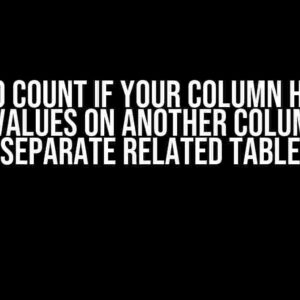Are you tired of manually subsetting your survey design in R? Do you struggle to iterate over objects in svytable? Look no further! In this comprehensive guide, we’ll show you how to dynamically subset your survey design using svytable, making your life easier and more efficient.
What is svytable?
Before we dive into the juicy stuff, let’s take a step back and understand what svytable is. svytable is an R package that provides a convenient and flexible way to work with survey data. It’s specifically designed to handle complex survey designs, allowing you to easily calculate margins of error, perform significance testing, and more.
Why Do We Need to Iterate Over Objects in svytable?
When working with survey data, it’s common to need to perform the same analysis on multiple subsets of the data. For example, you might want to calculate the mean income for different age groups or examine the response rates for various regions. Manually subsetting the data for each group can be tedious and prone to error. That’s where iterating over objects in svytable comes in.
Preparing Your Data for Iteration
Before you can start iterating over objects in svytable, you need to prepare your data. Here are the steps to follow:
-
Create a survey design object using the
svydesign()function from the survey package:R> library(survey) R> design <- svydesign(id = ~ID, weights = ~weights, data = my_data) -
Create a svytable object using the
svytable()function:R> library(svytable) R> table <- svytable(~variable, design = design)
Iterating Over Objects in svytable Using a Loop
One way to iterate over objects in svytable is using a loop. Here’s an example:
R> # Create a list to store the results
R> results <- list()
R> # Define the groups to iterate over
R> groups <- unique(my_data$age_group)
R> # Iterate over the groups using a loop
R> for (group in groups) {
R> # Subset the data for the current group
R> subset_data <- subset(my_data, age_group == group)
R> # Create a new survey design object for the subset data
R> subset_design <- svydesign(id = ~ID, weights = ~weights, data = subset_data)
R> # Create a new svytable object for the subset data
R> subset_table <- svytable(~variable, design = subset_design)
R> # Calculate the mean income for the current group
R> mean_income <- svymean(~income, design = subset_design)
R> # Store the results in the list
R> results <- c(results, list(list(group, mean_income)))
R> }This code iterates over each unique age group in the data, subsets the data for each group, creates a new survey design object and svytable object, calculates the mean income, and stores the results in a list.
Iterating Over Objects in svytable Using lapply()
Another way to iterate over objects in svytable is using the lapply() function. Here’s an example:
R> # Define the groups to iterate over
R> groups <- unique(my_data$age_group)
R> # Iterate over the groups using lapply()
R> results <- lapply(groups, function(group) {
R> # Subset the data for the current group
R> subset_data <- subset(my_data, age_group == group)
R> # Create a new survey design object for the subset data
R> subset_design <- svydesign(id = ~ID, weights = ~weights, data = subset_data)
R> # Create a new svytable object for the subset data
R> subset_table <- svytable(~variable, design = subset_design)
R> # Calculate the mean income for the current group
R> mean_income <- svymean(~income, design = subset_design)
R> # Return the results
R> list(group, mean_income)
R> })This code is similar to the previous example, but uses lapply() instead of a loop to iterate over the groups. The results are stored in a list, where each element is a list containing the group and the mean income.
Iterating Over Objects in svytable Using dplyr
Another way to iterate over objects in svytable is using the dplyr package. Here’s an example:
R> # Load the dplyr package
R> library(dplyr)
R> # Group the data by age group
R> grouped_data <- my_data %>%
R> group_by(age_group)
R> # Calculate the mean income for each group
R> results <- grouped_data %>%
R> do({
R> # Create a new survey design object for the current group
R> design <- svydesign(id = ~ID, weights = ~weights, data = .)
R> # Create a new svytable object for the current group
R> table <- svytable(~variable, design = design)
R> # Calculate the mean income for the current group
R> mean_income <- svymean(~income, design = design)
R> # Return the results
R> tibble(age_group = unique(. $age_group), mean_income)
R> })
This code uses dplyr to group the data by age group, and then calculates the mean income for each group using svytable. The results are stored in a tibble.
Conclusion
In this article, we’ve shown you three ways to iterate over objects in svytable: using a loop, using lapply(), and using dplyr. Each method has its own advantages and disadvantages, and the choice of method will depend on your specific use case.
By mastering the art of iterating over objects in svytable, you’ll be able to dynamically subset your survey design and perform complex analyses with ease. Whether you’re working with surveys, census data, or other types of complex data, these techniques will help you unlock new insights and take your analysis to the next level.
Resources
For more information on svytable and survey design, check out the following resources:
- The survey package on CRAN
- The svytable package on CRAN
- The survey package documentation
- The svytable package documentation
Summary
In this article, we’ve covered:
- What is svytable and why do we need to iterate over objects in svytable?
- Preparing your data for iteration
- Iterating over objects in svytable using a loop
- Iterating over objects in svytable using lapply()
- Iterating over objects in svytable using dplyr
By following the steps and examples in this article, you’ll be able to dynamically subset your survey design and perform complex analyses with ease.
| Method | Advantages | Disadvantages |
|---|---|---|
| Loop | Easy to understand and implement | Can be slow for large datasets |
| lapply() | Faster than a loop, easy to implement | Can be difficult to debug |
| dplyr | Faster than a loop and lapply(), easy to implement | Requires knowledge of dplyr syntax | Frequently Asked Questions



